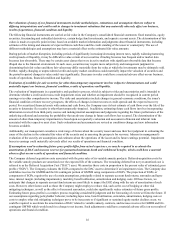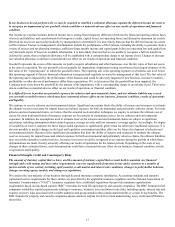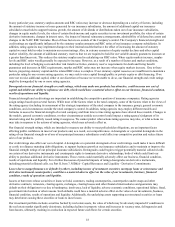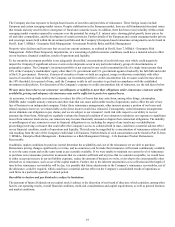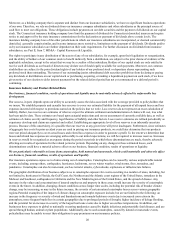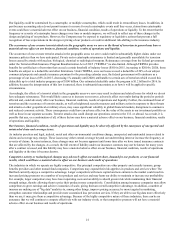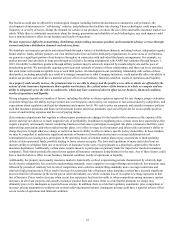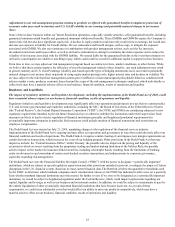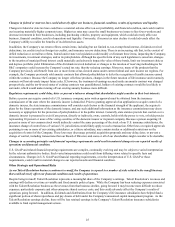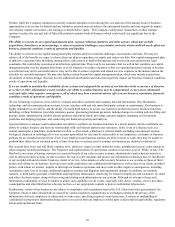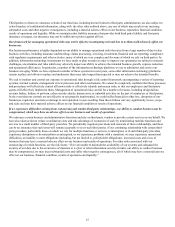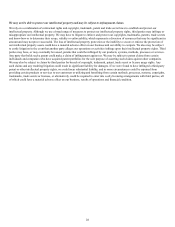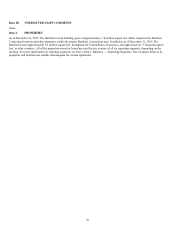The Hartford 2015 Annual Report Download - page 26
Download and view the complete annual report
Please find page 26 of the 2015 The Hartford annual report below. You can navigate through the pages in the report by either clicking on the pages listed below, or by using the keyword search tool below to find specific information within the annual report.26
Further, while the Company continues to actively consider alternatives for reducing the size and risk of the annuity book of business,
opportunities to do so may be limited and any initiatives pursued may not achieve the anticipated benefits and may negatively impact
our statutory capital, net income, core earnings or shareholders’ equity. The Company could pursue transactions or other strategic
options to reduce the size and risk of Talcott Resolution's annuity book of business which could result in a significant loss to the
Company.
The ability to execute on our capital management plan, expense reduction initiatives and other actions, which may include
acquisitions, divestitures or restructurings, is subject to material challenges, uncertainties and risks which could adversely affect our
business, financial condition, results of operations and liquidity.
The ability to execute on our capital management plan remains subject to material challenges, uncertainties and risks. We may not
achieve all of the benefits we expect to derive from our plan to repurchase our equity and reduce our debt. Our capital management plan
is subject to execution risks, including, among others, risks related to market fluctuations and investor interest and potential legal
constraints that could delay execution at an otherwise optimal time. There can be no assurance that we will in fact complete our capital
management plan over the planned time frame or at all. Initiatives to reduce expenses so that our ongoing businesses remain or become
cost efficient may not be successful and we may not be able to reduce corporate and shared services expenses in the manner and on the
schedule we currently anticipate. We may take further actions beyond the capital management plan, which may include acquisitions,
divestitures or restructurings, that may involve additional uncertainties and risks that negatively impact our business, financial condition,
results of operations and liquidity.
If we are unable to maintain the availability of our systems and safeguard the security of our data due to the occurrence of disasters
or a cyber or other information security incident, our ability to conduct business may be compromised, we may incur substantial
costs and suffer other negative consequences, all of which may have a material adverse effect on our business, reputation, financial
condition, results of operations and liquidity.
We use technology to process, store, retrieve, evaluate and utilize customer and company data and information. Our information
technology and telecommunications systems, in turn, interface with and rely upon third-party systems or maintenance. Our business is
highly dependent on our ability, and the ability of certain third parties, to access our systems to perform necessary business functions,
including, without limitation, providing insurance quotes, processing premium payments, making changes to existing policies, filing and
paying claims, administering variable annuity products and mutual funds, providing customer support, managing our investment
portfolios and hedging programs. and conducting our financial reporting and analysis.
Systems failures or outages could compromise our ability to perform our business functions in a timely manner, which could harm our
ability to conduct business and hurt our relationships with our business partners and customers. In the event of a disaster such as a
natural catastrophe, a pandemic, an industrial accident, a cyber attack, a blackout, a terrorist attack (including conventional, nuclear,
biological, chemical or radiological) or war, systems upon which we rely may be inaccessible to our employees, customers or business
partners for an extended period of time. Even if our employees and business partners are able to report to work, they may be unable to
perform their duties for an extended period of time if our data or systems used to conduct our business are disabled or destroyed.
Our systems have been, and will likely continue to be, subject to viruses or other malicious codes, unauthorized access, cyber-attacks or
other computer related penetrations. The frequency and sophistication of such threats continue to increase as well. While, to date, The
Hartford is not aware of having experienced a material breach of our cyber security systems, administrative and technical controls as
well as other preventive actions we take to reduce the risk of cyber incidents and protect our information technology may be insufficient
to prevent physical and electronic break-ins, denial of service, cyber-attacks or other security breaches to our systems or those of third
parties with whom we do business. Such an event could compromise our confidential information as well as that of our clients and third
parties, with whom we interact, impede or interrupt our business operations and may result in other negative consequences, including
remediation costs, loss of revenue, additional regulatory scrutiny and litigation and reputational damage. In addition, we routinely
transmit, to third parties personal, confidential and proprietary information, which may be related to employees and customers, by email
and other electronic means, along with receiving and storing such information on our systems. Although we attempt to keep such
information confidential, we may be unable to utilize such capabilities in all events, especially with clients, vendors, service providers,
counterparties and other third parties who may not have or use appropriate controls to protect confidential information.
Furthermore, certain of our businesses are subject to compliance with regulations enacted by U.S. federal and state governments, the
European Union or other jurisdictions or enacted by various regulatory organizations or exchanges relating to the privacy of the
information of clients, employees or others and, in some cases, specifying required control processes. A misuse or mishandling of
confidential or proprietary information being sent to or received from an employee or third party could result in legal liability, regulatory
action and reputational harm.


